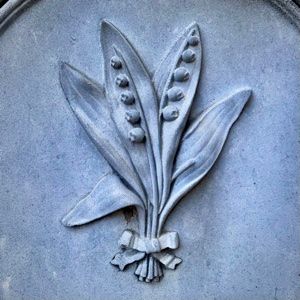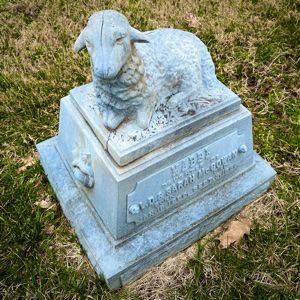White bronze tombstones: A technological advancement in death.

The American Industrial Age brought with it innovations to much of American life. The electric light, automobiles, refrigerators and other inventions completely changed how we live. There was innovation in every aspect of our lives and burial of the dead was not exempt.
In the 1870s, the Monumental Bronze Company of Connecticut turned tombstone production into a manufacturing business with their white bronze monuments. These monuments, molded from zinc, are more elaborate than standard flat stones and gave Americans the option of an impressive grave marker at a price cheaper than comparable chiseled rock. Though they look like well-preserved stone, they can be spotted today by their distinct blue patina. (Real bronze weathers green.) Lightly tap on one and they clang.

A model for American success.
Nine years after the company was founded they offered 2,000 monument shapes and had over 12,000 monuments sold. How is it one foundary in Connecticut got their tombstones and monuments in cemeteries across America? It boils down to good business practices:
- They had a superior niche product they could sell at a cheaper cost than carved stone.
- They had a wide offering from small monuments to bigger-than-life statues on pedestals.
- They created a manufacturing process that was difficult for competitors to duplicate.
- They built a distribution network.
- They had a visual catalog at a time when 20% of Americans were still illiterate.
- They had a product that made life easy for morticians who sold it to customers.
A big reason for the success of white bronze was a well-oiled model of mass production. Molded pieces of zinc were welded into monuments with holes left for the name plate and other ornamental plates, including dozens of fraternal order symbols, to be screwed on. Where stones were often hand carved, only the name plate needed to be individualized on white bronze. These were then sent to finishing and distribution centers as far south as New Orleans, as far north as Canada and as far west as Des Moines. The subsidiaries there added the personalized plates before delivery.

White Bronze today.
It’s hard to find an large, old cemetery in the East, Midwest and South that doesn’t have at least one Zinc monument. And if you find one there are likely others nearby, since a salesperson obviously worked the area. Despite the monuments all now weathering for over 100 years, most are in great shape today. Zinc doesn’t keep oxidizing like iron does. That thin bluish layer of oxidation that forms is pretty much impervious to the elements, even acid rain. So the lettering on zinc monuments is still fresh 150 years later. As Professor of Metallurgy J. W. Armstrong says in the Monumental catalog: “I can see no good reason why these monuments should not last as long as the Pyramids of Egypt.”
That might be a stretch. But the only real sign of wear I’ve seen on these monuments is when zinc-capped, steel rivets were used. These typically leave trails of rust on the name and ornamental plates or can dissolve inside the structure and cause the castings to separate. The owners of Monumental bronze thought their company would be around as along a people were dying. Sadly, production ended at the start of WWI when the government took over the factory to make gun mounts. No more were ever produced after that.

You’ll find more in my article Dying in America.
